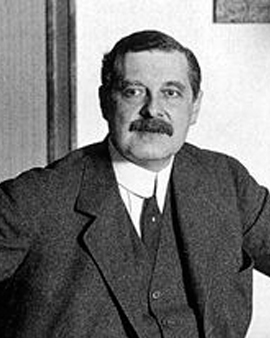


With the first morning sun of April 14, 1868, a child was born in Hamburg who would breathe the concept of modern industrial design into the world: Peter Behrens. This multidisciplinary artist - architect, painter, designer and typographer - would find his unique place in the vibrant Industrial Revolution and leave a lasting impact. Before the clouds of World War I, Behrens brought with him the fresh wind of practical and functional design. His decisive role in the founding of the Deutscher Werkbund and his extensive design work for AEG left a deep impression on the world of industrial design. His overarching sense of aesthetics was impressively demonstrated as he designed everything for AEG, from letterheads and products such as electric tea kettles to the factory buildings themselves. With his visionary practice, which would later become known as "corporate design," Behrens shaped the prototype of the industrial designer.
His office in Berlin hosted talented architects such as Walter Gropius, Ludwig Mies van der Rohe and Le Corbusier. Behrens also worked for the Klingspor Brothers type foundry, where he designed a number of typefaces, including the distinctive Behrens Antiqua in 1907. It is therefore not surprising that a high-quality reproduction of an art print of his work is in no way inferior to the original work. His creative power was inexhaustible, his creations were a visual expression of the transition of the era. Initially influenced by impressionism and naturalism, ornamentalist elements increasingly appeared in his works. This led to an inclination towards Art Nouveau, which he encountered in the Munich Secession. Later, during the letterpress phase, he increasingly introduced geometricizing forms into his work. This evolution from the decorative aesthetic of Art Nouveau to the geometric sobriety of Modernism is a key feature of his work.
His architecture was no accident, but a logical continuation of his aesthetic philosophy. His time at Mathildenhöhe in Darmstadt, an artists' colony, allowed him to comprehensively implement his design concepts, from houses to interior design to furniture. His work during this period strongly influenced the development of modern architecture. The structures he designed after World War I, such as the simple workers' housing estates and the complex administrative buildings of Farbwerke Hoechst AG, demonstrate his ability to meet the demands of his time. Throughout the 1920s, Behrens continued his development by designing buildings with complex floor plans as well as extremely structured public and administrative buildings. Leaving a luminous mark in the history of architecture and design, Peter Behrens paved the way for modern industrial design. The high quality of the art prints of his works that we offer today pay tribute to his legacy. More than mere reproductions, they are living testaments to transformation and change in art and design.

With the first morning sun of April 14, 1868, a child was born in Hamburg who would breathe the concept of modern industrial design into the world: Peter Behrens. This multidisciplinary artist - architect, painter, designer and typographer - would find his unique place in the vibrant Industrial Revolution and leave a lasting impact. Before the clouds of World War I, Behrens brought with him the fresh wind of practical and functional design. His decisive role in the founding of the Deutscher Werkbund and his extensive design work for AEG left a deep impression on the world of industrial design. His overarching sense of aesthetics was impressively demonstrated as he designed everything for AEG, from letterheads and products such as electric tea kettles to the factory buildings themselves. With his visionary practice, which would later become known as "corporate design," Behrens shaped the prototype of the industrial designer.
His office in Berlin hosted talented architects such as Walter Gropius, Ludwig Mies van der Rohe and Le Corbusier. Behrens also worked for the Klingspor Brothers type foundry, where he designed a number of typefaces, including the distinctive Behrens Antiqua in 1907. It is therefore not surprising that a high-quality reproduction of an art print of his work is in no way inferior to the original work. His creative power was inexhaustible, his creations were a visual expression of the transition of the era. Initially influenced by impressionism and naturalism, ornamentalist elements increasingly appeared in his works. This led to an inclination towards Art Nouveau, which he encountered in the Munich Secession. Later, during the letterpress phase, he increasingly introduced geometricizing forms into his work. This evolution from the decorative aesthetic of Art Nouveau to the geometric sobriety of Modernism is a key feature of his work.
His architecture was no accident, but a logical continuation of his aesthetic philosophy. His time at Mathildenhöhe in Darmstadt, an artists' colony, allowed him to comprehensively implement his design concepts, from houses to interior design to furniture. His work during this period strongly influenced the development of modern architecture. The structures he designed after World War I, such as the simple workers' housing estates and the complex administrative buildings of Farbwerke Hoechst AG, demonstrate his ability to meet the demands of his time. Throughout the 1920s, Behrens continued his development by designing buildings with complex floor plans as well as extremely structured public and administrative buildings. Leaving a luminous mark in the history of architecture and design, Peter Behrens paved the way for modern industrial design. The high quality of the art prints of his works that we offer today pay tribute to his legacy. More than mere reproductions, they are living testaments to transformation and change in art and design.
Page 1 / 1






